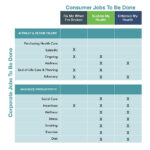August 30, 2022

Healthcare’s Jobs to Be Done (Part 2): Application
Editor’s note: By understanding what jobs customers pay products to do, innovative companies can design their products to get those jobs done. This series details the pathbreaking work on Clay Christensen’s “Jobs to be Done” at Harvard Business School and applies the jobs framework to healthcare.
Part 1: A Primer
Part 2: Jobs Framework
Clay Christensen’s insights on disruption and innovation have shaped my perspective on health industry transformation and featured prominently in both of my books. In Part 1 of this series, I detailed his pathbreaking work on “Jobs to be Done (Jobs)” at Harvard Business School. By understanding what “jobs” customers “hire” products to do, innovative companies can design their products to get those jobs done.
With Jobs, Christensen has created a powerful analytic framework for assessing company positioning and strategy. It enables company leaders to understand what businesses they’re actually in. With this understanding, they can make investments and allocate resources in ways that truly solve customers’ needs.
For example, the car company Ford today realizes it is in the mobility business as well as the business of vehicle manufacturing and sales. With this understanding, Ford has discovered new Jobs in transit, ridesharing, vehicle-sharing, consumer experience and autonomous vehicles to literally fuel its growth.
Jobs theory augments traditional approaches to strategy that emphasizes demographic profiling and market segmentation. Without a focus on Jobs, companies market to specific groups rather than to specific customer needs. By ignoring the elemental logic of why customers make purchasing decisions, they default to commoditized product offerings, miss important market signals and misallocate precious corporate resources.
Importantly, the Jobs framework forces company leaders to undertake two essential tasks when confronting disrupting markets and new competitors. First, it gives them the tools to evaluate the effectiveness of current product offerings in solving real customer problems. Secondly, it nudges them to source new opportunities for investment. In this bottom-up, organic way, Jobs infuses strategy with innovation.
Healthcare and Disruption
Healthcare’s governing business principle is optimizing revenue under fee-for-service (FFS) payment and administrative-services-only (ASO) contracting. Healthcare’s “customers” are primarily government payers (e.g., Medicare and Medicaid) and self-insured employers who design and purchase healthcare insurance on behalf of their enrollees/members.
 Given this business paradigm, providers maximize revenues by optimizing claims documentation for complex payment formularies that determine payment for specific procedures. The importance of procedure billing and collection for healthcare companies accounts for the massive scale of their revenue cycle operations.
Given this business paradigm, providers maximize revenues by optimizing claims documentation for complex payment formularies that determine payment for specific procedures. The importance of procedure billing and collection for healthcare companies accounts for the massive scale of their revenue cycle operations.
Equally important, relative negotiating leverage between providers and commercial health insurance companies determines payment rates for specific procedures administered to commercially insured patients. These commercial payment rates exhibit wide variation for identical procedures and often are multiple times higher than governmental payment rates.
Healthcare’s perverse market dynamics lead to over- and undertreatment, over- and underpayment and a profound maldistribution for facilities and practitioners. They incentivize treatment over prevention. They fragment service provision. Lost in this grand payer-provider dance are the actual Jobs that healthcare consumers want healthcare companies to solve.
Disruption has come to healthcare because the industry is lousy at solving real customer needs. Understanding healthcare Jobs from both consumer and employer perspectives is fundamental to value-based care provision. As the healthcare system transitions toward value, innovative companies that solve Jobs will find increasing numbers of consumers and employers who want to hire their products.
These innovative companies will steal customers from complacent incumbents by knowing what businesses they’re in, by defining Jobs accurately, and by solving real customer problems. Traditional healthcare providers and payers should be afraid, very afraid.
Marrying Strategy and Innovation
Markets are inherently volatile. Companies rise and fall. The composition of the S&P 500 index captures the market’s inherent volatility. Only Microsoft remained a top-five S&P 500 company, as measured by market capitalization, from 2009 to 2018.
In a September 2018 article, Kevin McVeigh details the mechanics of adding and deleting companies from the index. The historical 4.4%. turnover rate means that roughly 22 companies come in and out of the index annually. Between 1999 and 2018, S&P replaced more than half of the 500 companies in its index. Of those replacement companies, just over sixty were still active in 2018. The only constant in markets is change.
Recognizing the need for business leaders to manage through increasing market volatility, Clay Christensen and Mark Johnson founded the consulting company Innosight in the year 2000. By applying Christensen’s work on disruption and innovation, Innosight helps companies accelerate transformational change. Particularly in disrupting industries, companies cannot wait for historical performance data to drive change. They must look forward to discover opportunities for strategic growth.
 In this sense, strategy and innovation go together like love and marriage. Understanding Jobs and finding unfulfilled customer needs exemplify the right-minded approach to strategy. They inspire successful innovation. As detailed in Part 1, sources of future growth and innovation include poorly-solved problems, nonconsumption, workarounds, avoided tasks and new uses for established products. Healthcare has these “opportunities” in abundance.
In this sense, strategy and innovation go together like love and marriage. Understanding Jobs and finding unfulfilled customer needs exemplify the right-minded approach to strategy. They inspire successful innovation. As detailed in Part 1, sources of future growth and innovation include poorly-solved problems, nonconsumption, workarounds, avoided tasks and new uses for established products. Healthcare has these “opportunities” in abundance.
Relative to other industries, healthcare has been remarkably stable. Incumbents have largely remained intact as the industry’s highly regulated payment and operating mechanics support status quo business practices. This has separated industry payers and providers from the interactive signaling that governs supply-demand dynamics in high-functioning market environments.
Absent the critical signaling that accompanies purchasing decisions in competitive markets, value creation and consumerism in healthcare have atrophied. This is changing. Payment models are slowly shifting away from FFS and ASO contracting toward value-based care provision. As this shift takes hold, healthcare companies will remain competitive only by offering value-based products that consumers want.
Rather than the exception, disruption will become the norm as incumbents battle new entrants to remain relevant. In the process, healthcare will change more in the next ten years than it has in the last one hundred. To navigate that change, incumbent health companies will need to look forward to design and execute strategies that solve customer problems.
Thought Leadership Shapes Strategy and Innovation
A core feature of Innosight’s consulting practice is incisive thought leadership. Good writing leads to good thinking, not the reverse. The effort to create a cohesive narrative clarifies ideation, flow and insight. It expands intelligence. The hard work of writing reveals itself through cogent presentation. It invites readers to engage in intellectual exchange and debate. In disruptive times incisive thought leadership guides enlightened business leaders.
In 2017, the Huron Consulting Group acquired Innosight to turbocharge their healthcare, education and life sciences practices. At the time, my company 4sight Health was working with Huron to develop thought leadership content. The Innosight acquisition paved the way for me to co-author commentaries with Innosight partners Andy Waldeck and John Poulin.
In “Gawande’s Gift,” Andy and I explored corporate wellness and healthcare Jobs when Haven Health announced Atul Gawande’s appointment as their first CEO. Despite Haven’s demise, its intention of using corporate purchasing power to drive better healthcare purchasing and expand value-based care continue to shape industry transformation.
In “After the Breakups,” John and I explored the shift by big payers into vertical integration after the Justice Department’s legal challenges nullified the horizontal Aetna-Humana and Anthem-Cigna mergers. Our conclusion was that better demand management among large payers through vertical integration will push the industry toward higher value purchasing and care delivery.
I learned an enormous amount working with Andy and John. Our intellectual jujitsu created fresh and compelling content. Andy’s and my work on healthcare Jobs is particularly relevant to incumbent repositioning strategies. I incorporated that content into the “Revolutionary Upstarts” chapter of my last book, “The Customer Revolution in Healthcare: Delivering Kinder, Smarter, Affordable Care for All.”
Healthcare’s Jobs to be Done
There is an enormous mismatch between the services that consumers want and those that the healthcare system offers. America’s healthcare system is treatment-centric and fragmented. It does a poor job of preventing disease, managing chronic conditions and addressing mental health challenges. These shortcomings create opportunities for new and existing companies to gain market relevance by targeting neglected and/or underserved healthcare customers.
 The best way for incumbents to address this services-needs mismatch is by understanding and solving the health and healthcare “Jobs” that consumers and employers need done. This Jobs focus enables healthcare companies to allocate their resources in ways that achieve both near and longer-term success. The functional matrix below identifies consumer and employer Jobs as well as how those Jobs intersect with one another.
The best way for incumbents to address this services-needs mismatch is by understanding and solving the health and healthcare “Jobs” that consumers and employers need done. This Jobs focus enables healthcare companies to allocate their resources in ways that achieve both near and longer-term success. The functional matrix below identifies consumer and employer Jobs as well as how those Jobs intersect with one another.
Essentially, individual consumers have three “Jobs” regarding their health and wellness.
- Fix me when I’m broken: Treat an acute illness or injury effectively, so individuals can return to their previous health status.
- Sustain my health: Support a consumer’s existing health journey, enabling them to accomplish what is important and feasible given their existing health status.
- Enhance my health: Enable a consumer to make the necessary changes to improve their health status.
Employers essentially have two Jobs that healthcare and other associated benefits solve. These jobs are the need to attract and retain top talent and the need to maximize employee productivity. Offering attractive health benefits and engaging in workplace wellness are proven strategies for getting and keeping productive employees productive.
Consumers’ first job, “Fix Me When I’m Broken,” falls squarely within the purview of the healthcare system. Parts of the second and third do as well. To facilitate an employee’s ability to “Sustain My Health” and “Enhance My Health,” consumers and employers must acknowledge and address the reality that lifestyle choices have a far greater impact on long-term health than medical treatments.
All three “Jobs” require the active engagement of individual consumers to achieve optimal results. While heart-attack patients receive medical care in hospitals, full recovery requires medication adherence and lifestyle changes. Changing individual behaviors increases in importance in consumers’ healthcare Jobs two and three. Changing lifestyle behaviors is not a core health system capability. It must become one.
For the most part, employers have not been effective purchasers of healthcare services, nor have they created wellness-oriented working environments/cultures. They are getting better at helping employees “solve” their health and healthcare Jobs. As described below, this is occurring through enhanced benefit design, healthcare purchasing, corporate wellness and end-of-life care/planning:
- Benefit design: Promoting more holistic care coverage through benefit structures that incorporate both health and social care services. Encouraging employees to seek the right care at the right time in the right place at the right price with a creative mix of financial and health-oriented incentives. Capturing and measuring improvement in biometric health data. Rewarding those who improve.
- Healthcare purchasing: Developing high-performing networks that funnel volume to high-quality, high-value providers. Helping employees make the right healthcare decisions consistently with second opinions and care navigation services. Making primary care easily available through on-site clinics or convenient local providers (e.g., One Medical). Pioneering technologies that support informed healthcare decision-making. Using market leverage where possible to support direct contracting for episodic care and shifting care management risk to third parties.
- Corporate wellness: Prioritizing the health of the many over the medical care for the few. Being patient, since successful corporate wellness programs require behavioral change, which takes time. Creating personalized wellness programs that accommodate individual preferences and circumstances.
- End-of-life care / planning: Recognizing that the cost and pain associated with ill-advised end-of-life care is astronomical and unacceptable. Helping employees proactively make thoughtful end-of-life care plans for themselves eases life transitions and improves productivity. Everybody wins.
Together, consumer and employer Jobs will reshape the industry’s supply-demand dynamics. Understanding and solving these Jobs is essential for long-term market relevance and sustainability.
Conclusion: Reciprocal Benefit
Trends that cannot continue won’t. American healthcare is at a major inflection point that requires full commitment to value-based delivery and community wellness.
Former Cleveland Clinic CEO Toby Cosgrove observed that “the state of our nation depends upon the state of our health.” As America emerges from the pandemic, Toby’s declaration has never been truer. The nation cannot afford more of the same wasteful and misguided approach to healthcare service provision.
Shakespeare’s most accomplished female character is Portia in The Merchant of Venice. In the play’s climactic trial scene, Portia (disguised as a young lawyer) pleads for Antonio’s life by pointing out the dual benefits of mercy:
The quality of mercy is not strained.
It droppeth as the gentle rain from heaven
Upon the place beneath. It is twice blest:
It blesseth him that gives and him that takes.
‘Tis mightiest in the mightiest; it becomes
The thronèd monarch better than his crown…
Health and healthcare Jobs have the same reciprocal character. By solving the Jobs to Be Done of consumers and employers, healthcare companies can deliver real value to their customers while benefiting themselves from greater customer loyalty, increasing market share and banking higher returns on investment.
In this sense, Jobs pays enormous dividends to innovative healthcare companies and more broadly to American society. Reclaiming America’s health, wellness and well-being is this generation’s greatest challenge. Healthcare companies that lead this charge will grow enabling consumers and employers to make value-based purchasing decisions that solve real problems. Those that don’t will lose market relevance. Many will fade into obscurity.





